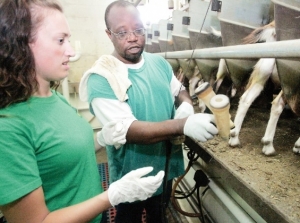Time to milk the goats ...
By Laura Collins
Published in News on June 21, 2010 1:46 PM

Troy Herring
Reporter Laura Collins watches and listens to instructions from Holly Grove Farms employee Shelton Newsome on the proper way to milk a goat.
The Job: Goat cheese farmer
The Company: Holly Grove Farms, Inc.
The Location: Mount Olive
It's been brought to my attention that my aim is off, courtesy of one very uncomfortable goat.
I started my shift at Holly Grove Farms with Brittany Craig, assistant manager of the farm, and one of many Craigs who run the family-owned operation. Our first stop was the milk parlor where about 900 goats are milked twice a day.
"You aren't going to be scared of the animals, are you, because you're right at their butt," Ms. Craig said.
The parlor has 48 stalls which are about four feet off the ground and position the back of the goats toward the milker. When I stepped down into the parlor, I was literally surrounded by hind legs, udders and tails.
"They won't kick," she said, which made me feel better, but then she added, "but if they do, it won't hurt because their legs are smaller," which made me not believe her first statement.
Employees Amaila Baltazar and Shelton Newsome showed us the process. Once the goats are in their stalls, their teats are sprayed with iodine and wiped down squeezing out some milk by hand in the process to remove any clogs or dirt or hair. Then the milking machine, which looks like two suction cup tubes, is hooked up to teats and completes the milking process. Aaron Moore, an intern at the News-Argus, came along for the day, and since there were 48 goats I definitely needed his help.
My first road block came as we were sterilizing the teats. I was having a lot of trouble making any milk come out by hand. Ms. Craig tried to help, and we quickly realized that I was only capable of milking by hand when she did it with me.
Since the first step wasn't my forte, I was running a little behind hooking up the milking tubes. I was going down the line of goats slipping the milking tubes on the teats when I ran into one rather feisty goat that was stomping her feet. In between stomps, I somehow got close enough to attach the milking tube, and I moved on down the line.
A few minutes later, though, one of the other workers noticed that her udder was not decreasing in size, which happens as the goats are milked. I looked around for Intern Aaron, hoping I could somehow blame him, but Ms. Craig sold me out.
"Laura, isn't that the one that was kicking?" she said.
"That's possible," I said, even though I knew it was.
The goat was still as fidgety as she was when I first tried to get the tubes on. As I got closer I saw the problem. In my haste to get the tube on between kicks, my aim was off and I missed her teat. I stuck the suction tube directly on her udder. Not good. As I reached up to fix my mistake, she kicked my arm. I don't blame her.
As we were the leaving the milking parlor, Intern Aaron gave me a recap of what he did, then he added:
"They said I could probably get a job out here."
"That's weird, I don't think they said that to me," I said.
We took a brief break and tried some of the cheese. In addition to their fresh chevre, which is plain goat cheese, the farm carries a variety of flavors including southwest blend, jalapeno, chive and basil. The cheeses are all natural, with salt being the only added ingredient. The goats produce about 2,000-3,000 pounds of cheese each week.
Ms. Craig describes the goat farm as her "dad's adventure," an adventure that has become a family affair. When her father, Ron Craig, died a year ago, she said there was no thought put into shutting down the farm.
"It never crossed anybody's mind," she said. "We thought, OK, it's time to come together and keep this thing going."
And they have. The farm has very few employees that are not part of the Craig family. In addition to Brittany and her mother, her brothers Shane and Jesse Craig, and her sister Casey Fuller, all have a hand in keeping the farm running and successful. What started out as a unique interest of Ron Craig has turned into a labor of love for his wife and children.
